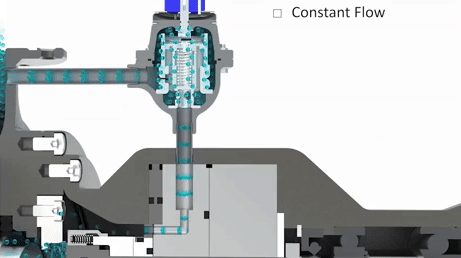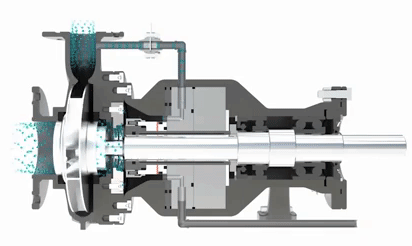What is a Mechanical Pump Seal Plan and Why Are They Important?
Custom Valve Concepts Kates Flow Controllers have been and continue to be the go-to product for flow control in mechanical seal applications. Compared to a standard orifice plate or flow restrictor, the seals will continue to receive a constant set flow rate regardless of system pressure fluctuations. Mechanical Pump Seal Plans are critical to the longevity of the equipment they are being used on. For instance, if a seal fails then the machine it is on can not be operated until a new seal is installed. The Kates unit takes the guesswork out of mechanical seal flush flow control and gives maintenance peace of mind.
What is a mechanical seal plan?
A mechanical seal flush plan is an equipment piping arrangement that uses fluid from the process or an external source in order to prevent leakage, maintain desired lubrication, pressure, & heat within a seal. They also handle solids entrained in the process liquid and keep them from damaging the seal face and can indicate when a failure has occurred at the seal. There are certain seal flush plans that create a gas barrier inside the seal to prevent dangerous or expensive liquids and gas emissions from leaking out of the process system by pressurization or recovery.
The seal plan is essentially a system to provide the mechanical seal with the ideal operating conditions in order to prolong its effective use by preventing the delicate mechanical seal internals from experiencing overheating, vaporization of lubricant, or solids entrained in the process liquid.
When are they typically used & why?
There are many reasons someone might use a seal plan, but there are 4 categories of seal plan (Single, Dual, Quench, and Gas) that all perform critical seal support functions. Single seal plans are utilized to remove heat from the seal chamber, provide lubrication to the seal faces, maintain hydrostatic pressure in the seal chamber to prevent vaporization of lubricant, and remove solids from process liquid to be used for seal flush. There are a variety of seal plans that perform this function in different ways based on your operating conditions.
Dual seal plans are focused on providing a barrier between the two sealing points of the dual seal, this is to prevent process fluid from leaking to the atmosphere (high vapor pressure, hazardous, or expensive liquids) and to isolate the process fluid from contamination by the flush liquid(which happens freely in single flush plans).
Quench seal plans are used on single mechanical seals to indicate and measure seal failures in critical applications, minimize leakage in case of primary seal failure, and to maintain the seal conditions by preventing the seal from freezing and preventing solids from building up in crystalizing fluids using steam, nitrogen, or water to flush the seal. They prove useful in critical services at remote locations where the pump cannot be as closely monitored.
Gas seal plans are utilized with dual mechanical seals to create a barrier for the primary seal in case of failure and support the second seal face. Their functions include minimizing atmospheric leakage by collecting leaked process gases/liquids and indicating failures in the seal. These sealing techniques provide a nitrogen gas barrier that can be pressurized or unpressurized to slow or eliminate emissions. Useful when liquid barriers are not suited to the application.
The mechanical seal in any machine is one of the most commonly replaced wear components, accounting for close to 70% of all rotating equipment repairs, so being able to support the seal and prevent wasteful misapplication is absolutely critical to preventing downtime.
What should you look for when choosing a mechanical seal plan?
API 682 4th edition uses flow charts (sheets 7, 8, &9 of Annex A) to guide pump users through selecting a flush plan. The following is how I choose one “the old-fashioned way”. The first step in the process would be to narrow your search by confirming whether you have a dual or single seal assembly, this information will provide you with a shorter list of seal plans that are usable with your application. Dual seals can be further split into pressurized and unpressurized categories. Plans 01-41 and plans 62-66B are for single seals, while plans 52-55 and 72-76 are designed for use on dual seals (pressurized dual plans include 53-54, 74-76 and unpressurized dual plans include 52, 55, 72). The next step would be do identify which undesirable conditions you are trying to prevent in the seal chamber. These conditions could be overheating, solids in the seal chamber, lack of lubrication, hazardous media leaking to atmosphere, Etc. Once you have all this information, looking through a Mechanical Seal Piping Plan poster should bring you close to the finish line. Let’s say you have a single seal in a pump used to circulate hot water with small pieces of metal in it. Only 01-41 & 62-66B will work with a single seal, so you can narrow your search to those plans. A quick reference of a piping plan poster will show you a plan 21, which pipes the discharge of the pump to a cooler and would help dissipate the high heat of hot water from the flush fluid but not remove the solids. Plan 31 pipes the discharge to a cyclone separator to remove solids but will not remove the heat necessary to keep the seal faces from being damaged. Plan 41 is a combination of the 2 plans that pipes the discharge of the pump to a cyclone separator, the separator is piped to a cooler, and that cooler is piped to the seal chamber flush. This is the exact flush plan that should be utilized for this application. Knowing the type of seal you are working with and the undesirable conditions you are trying to prevent in the seal chamber will allow you to greatly narrow down your options, a little bit of searching through your handy API Piping Plan chart will get you the rest of the way.
Below is a guide to help you determine which seal will work best for your needs:
1. Single Seal
1. Horizontal pumps – use Plan 11 (Plan 21-41, 62 may be preferable)
2. Vertical pumps – use Plan 13 or Plan 14 (Plan 32, 62 may be preferable)
2. Dual Unpressurized Seal
1. Horizontal pumps – use Plan 52/55
2. Vertical pumps – use Plan 52/55 or 52/55
3. Dry containment seals – use Plan 72 instead of 52
3. Dual Pressurized Seal
1. Wet systems – use Plan 53A (although some prefer 53B or 54)
2. Dry systems – use Plan 74
4. Leakage monitoring
1. Single Seal – use Plan 65 or 66
2. Dual Unpressurized Seal
1. Plan 52 includes monitoring (level indicator)
2. Plan 72 needs Plan 75 or 76 for monitoring
3. Dual Pressurized Seal
1. Plan 53, 54 includes monitoring (level indicator)
2. Plan 74 includes monitoring (pressure transmitter)
5. Leakage management
1. Single Seal – use Plan 65 or 66
2. Dual Unpressurized Seal
1. Plan 52 includes management (if piped to disposal)
2. Plan 72 needs Plan 75 or 76
3. Dual Pressurized Seal - does not include leakage management
Why are mechanical seal plans important?
Mechanical seals, despite their small size, are usually multi-thousand-dollar items that are critical to the longevity of the equipment they are used on. If a seal fails then the machine it is on cannot be operated until a new seal is installed, this down time is the worst fear of every production facility. When a seal fails you have to find a replacement seal (which may have a week’s long lead time), have the seal shipped to you, and schedule to have it installed on your equipment (which can take days). Even if you are well prepared for a seal failure, with a replacement seal in your stock room, there is a need to shut down the machine so a technician can perform the service and this process can take several hours in the best of scenarios. Mechanical seal lifetimes and mean time between repair can be increased multiple times over by providing the seal with consistent conditions to perform in via a seal flush plan, allowing companies to focus more of their time and energy on tasks that grow their business as opposed to constantly trying to take care of the repeated failures of machinery in production.
The equipment mechanical seals are used on (Pumps, Compressors, Mixers, Etc.) are usually very expensive capital expenditures that can cost tens of thousands to millions of dollars and when a mechanical seal fails they sometimes do damage to the machine they are installed on. Whether that be damage to the rotating shaft caused by the broken seal scratching the shaft or leaked process fluid causing erosion of the machine, the cost of a failed mechanical seal is so much more than just the cost of its replacement.
Why choose Kates in your seal plan?

The Kates Automatic Flow Controller simplifies your mechanical seal plan by eliminating the need for initial orifice plate sizing and allows for changes in process media without the need for resizing of orifice plate. It ENSURES that the proper flow rate of gas or liquid will be fed into your seal, regardless of pressure changes in the flush supply or seal chamber, while also preventing waste of the flush fluid/gas by maintaining the minimum necessary flush rate. The Kates is dial adjustable, so you can easily increase or decrease flow rates when this adjustment is necessary. You don’t want to rely on archaic, unreliable flow control devices when a moment of dry run can destroy your seal, damage your rotating equipment, and shut down your production line. The Kates unit takes the guess work out of mechanical seal flush flow control and gives maintenance peace of mind.
KATES - API 682 Seal Flush Plans

Sign up to receive the CVC Engineering Insights in Your Inbox:
Join us on Social Media!





Learn more about Custom Valve Concepts
Blog categories
- mechanical design (7)
- General (15)
- history (1)
- quality (4)
- manufacturing (4)
- meet the team (4)
- FAQ Kates (3)

